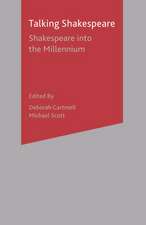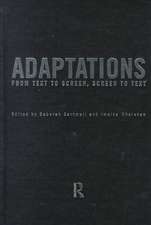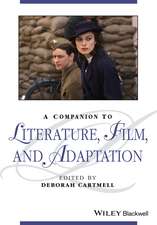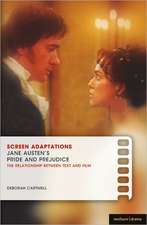Adaptations in the Sound Era: 1927-37: Bloomsbury Adaptation Histories
Autor Dr. Deborah Cartmellen Limba Engleză Paperback – 29 iul 2015
Preț: 190.06 lei
Preț vechi: 214.23 lei
-11% Nou
Puncte Express: 285
Preț estimativ în valută:
36.37€ • 37.74$ • 30.40£
36.37€ • 37.74$ • 30.40£
Carte tipărită la comandă
Livrare economică 15-29 martie
Preluare comenzi: 021 569.72.76
Specificații
ISBN-13: 9781623568788
ISBN-10: 1623568781
Pagini: 176
Ilustrații: 14 bw illus
Dimensiuni: 152 x 229 x 13 mm
Greutate: 0.27 kg
Editura: Bloomsbury Publishing
Colecția Bloomsbury Academic
Seria Bloomsbury Adaptation Histories
Locul publicării:New York, United States
ISBN-10: 1623568781
Pagini: 176
Ilustrații: 14 bw illus
Dimensiuni: 152 x 229 x 13 mm
Greutate: 0.27 kg
Editura: Bloomsbury Publishing
Colecția Bloomsbury Academic
Seria Bloomsbury Adaptation Histories
Locul publicării:New York, United States
Caracteristici
Enables students to contextualise adaptations in relation to technical change, marketing materials and audience reception
Notă biografică
Deborah Cartmell is Professor of English and Director of the Centre for Adaptations at De Montfort University, UK, founder and co-editor of the international journals Shakespeare and Adaptation, founder and former Chair of the Association of Adaptation Studies.
Cuprins
Chapter 1: Introduction: Early Reactions to Sound Adaptations Chapter 2: The Taming of the Shrew (1929) and the First Adaptation of ShakespeareChapter 3: Sound Shakespeares in the 1930sChapter 4: Sound Dickens in the 1930sChapter 5: Sound and Early 1930s Biopics: Disraeli (1929), The Private Life of Henry VIII (1933), Cleopatra (1934), The Barretts of Wimpole Street (1934)Chapter 6: Sound and the Gothic Survival of 1931 Chapter 7: Conclusion: The Sound Adaptation GenreReferences: Key Critical Works and a List of Adaptations
Recenzii
Adaptation studies thrive amongst the complex and fertile interactions of writing, theatre and film. Disciplinary boundaries, professional territorialism and critical conventions often impede our access to the truth about those cultural relationships. Deborah Cartmell's new book provokes us to dismantle barriers, disown vested interests and think again about the written and spoken word and their screen manifestations. Using the transition from silent to sound movies as a test-case, Cartmell demonstrates, with erudition, acumen and penetrating theoretical insight, that screen adaptations need to be explained by their economic, political, social and cultural entanglements, and not as separable 'works' of literature, drama or film.
Deborah Cartmell makes an important and foundational contribution to the growing scholarship that brings a film historical approach to adaptation studies. Organised around the introduction of sound to cinema and considering a range of film adaptations-from Shakespeare to children's literature-Cartmell focuses her study on the marketing and promotional material of the films and considers them in relation to film critics' ambivalence about the new technology and literary critics' anxiety about mass-produced culture. Adaptations in the Sound Era clearly articulates the importance of this decade for establishing the expectations for and debates about fidelity that have dominated adaptation studies ever since, making it a must-have for anyone who studies film adaptation in any period.
Deborah Cartmell makes an important and foundational contribution to the growing scholarship that brings a film historical approach to adaptation studies. Organised around the introduction of sound to cinema and considering a range of film adaptations-from Shakespeare to children's literature-Cartmell focuses her study on the marketing and promotional material of the films and considers them in relation to film critics' ambivalence about the new technology and literary critics' anxiety about mass-produced culture. Adaptations in the Sound Era clearly articulates the importance of this decade for establishing the expectations for and debates about fidelity that have dominated adaptation studies ever since, making it a must-have for anyone who studies film adaptation in any period.


















